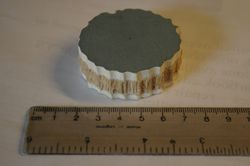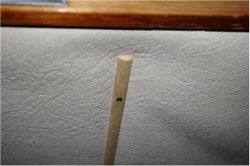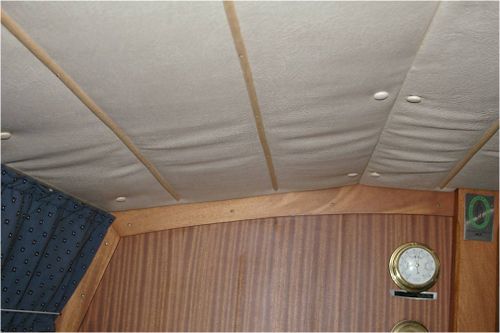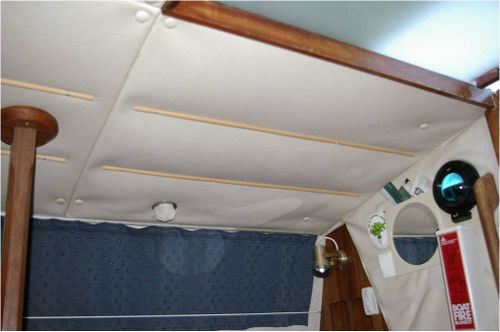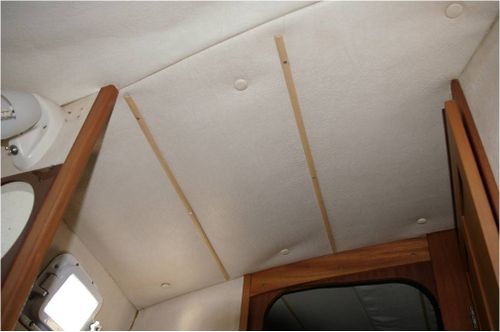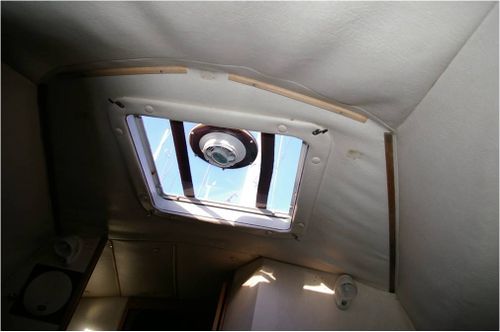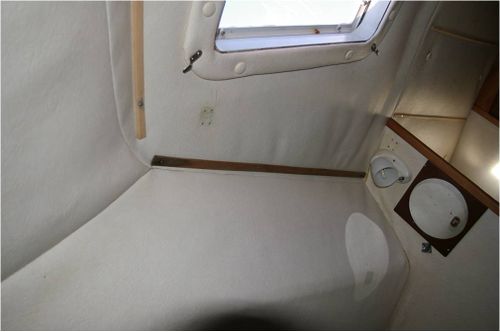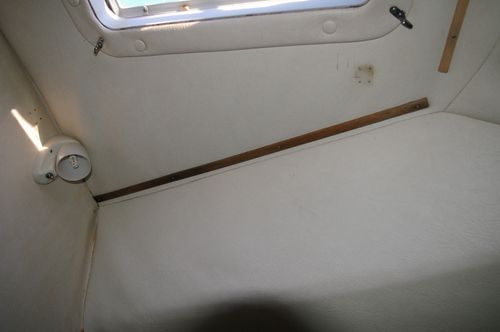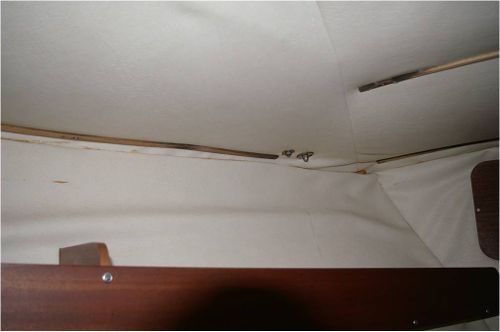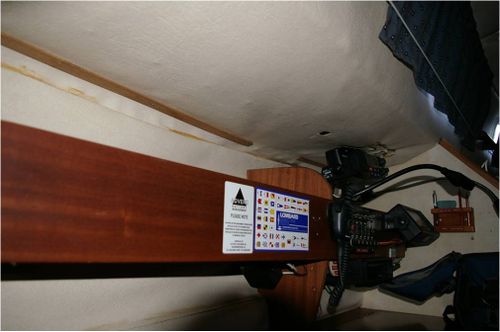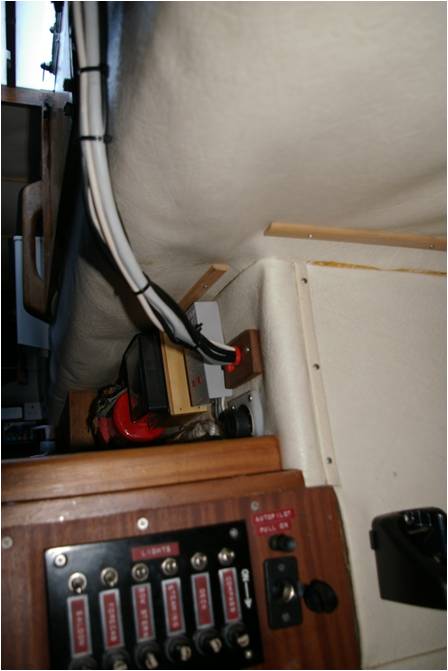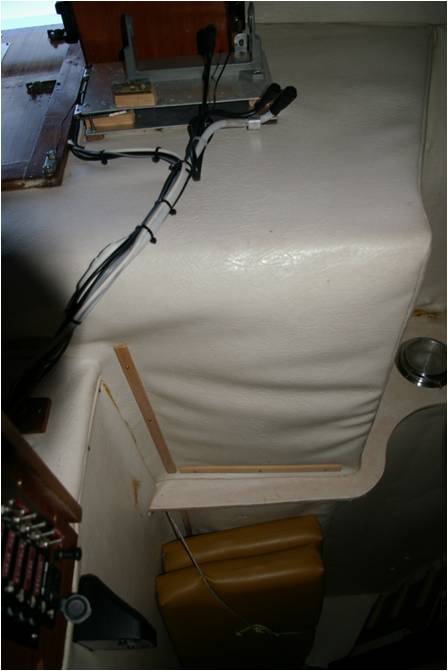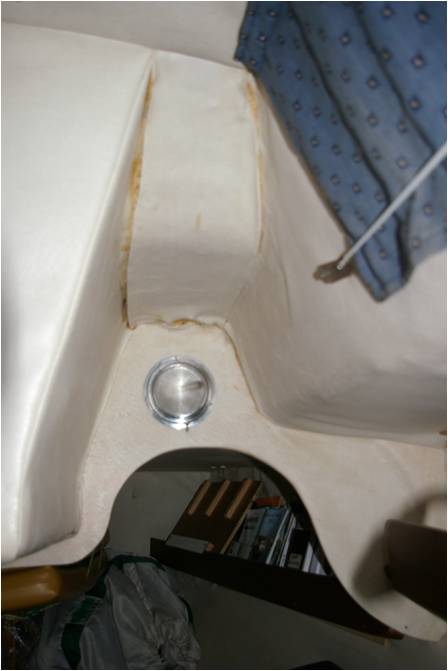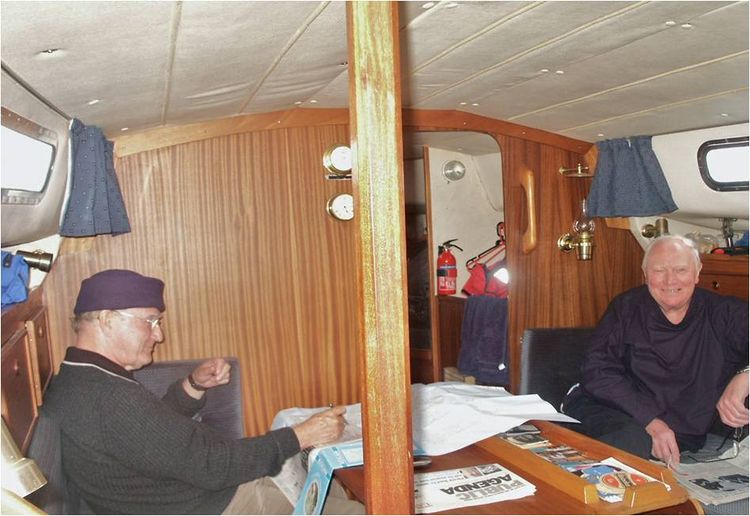One Konsort Owner's Approach
Contents
Headlining again! One Konsort owner's approach
If you own a Westerly, and your headlinings have not yet drooped, you can be sure they will at some future date.
We have owned our 1980 Konsort since 1987, so have been through this whole process. The root of the problem is that the adhesive foam that Westerly used on the back of the vinyl linings degrades with age; typically, it will start to separate from the structure on which it is mounted after 10-15 years. There are commercial operators who advertise in the WOA magazine and will tackle the issue for you, at a price. My approach was DIY, and the cost for all work so far has probably not exceeded £50.
The issue has been covered many times in the WOA magazine. This article is based on a presentation to an East Coast Group Winter Clinic in March 2013. I emphasise that it is only one owner's approach, and it is entirely about one Konsort. Other types will have both similarities and differences.
The method I chose is based around using battens wherever possible. Before going into detail, it's worth looking at the Westerly build sequence, as it has implications for lining repair.
Westerly Build Sequence
After moulding the hull, two longitudinal stringers were moulded in; these run from about the waterline at the stern to about half-way up the stem at the bow. They are a lightweight foam, perhaps polystyrene, glassed in. Then all the berth bases and the main bulkhead were fitted and glassed in, along with the floor reinforcements. Next came the hull lining; in the Konsort, 2 pieces each side, respectively ahead of and aft of the main bulkhead. After this so, on top of the lining were fitted the prefabricated units that comprise the head, hanging locker, saloon lockers, galley, chart table, and engine box. Thus all these units have lining vinyl fitted behind them.
The deck and cockpit comprise a second GRP moulding, laid up inverted. The forecabin lining, consisting of several pieces stitched together before fitting, and the coachroof linings, were fitted before the unit was turned right way up and fitted to the hull. Finally, the hull and deck linings were glued together; the joint is visible along the length of the boat, just below deck level.
Three cases for repair
There are 3 types of construction in the boat that need to be approached in different ways:
1. Saloon overhead panels: the lining is fitted to thin removable ply panels.
2. Sandwich decks: the side decks and coachroof deck have about 5mm of GRP on top, then 9mm of end-grain balsa, and 3mm GRP below; total about 17mm.
3. Solid hull sections such as topsides, and coachroof front and sides.
Fig.1:Sandwich Deck sample
Equipment and tools
If possible, the first requirement is a helper otherwise you will find that you run out of hands and arms.
Other items:
Evostick (in cans, for the amount required)
Brushes or other applicator for the Evostick
Evostick remover but be careful, it will dissolve vinyl
Battens, preferably hardwood
Stainless steel screws I used ½ inch No 6.
Also:
Stiff brush for cleaning the back of the lining; a blunt scraper is also useful
Vacuum cleaner if possible
Stanley knife
Drill, preferably electric cordless (a drill with a right-angle drive can be very useful)
Drill bits clearance, countersink, and pilot.
And time and patience!
I have found Evostick to be fine. There are reports that eventually it may leach through the vinyl and stain the visible surface; all I can say is that it has not happened to me. I know that other owners have used adhesives that are sold for car upholstery work, but I have no details.
For battens, I have found D-shaped hardwood 15mm x 5mm to be ideal.
Fig 2: 15mm x 5mm Hardwood Batten
I have also used softwoods, and other sizes of timber. My choice has been to leave the battens without any finish such as varnish or lacquer, but that is an individual option.
Overhead panels
The saloon overhead panels are a good place to start; they can be removed easily and most of the work done outside the boat. Beware the degraded foam it is awful stuff. When trodden on, it turns into a sticky black mess that is difficult to remove, so it's worth taking precautions to keep it away from upholstery, the cabin sole, and anything else you want to stay pristine.
The widest overhead panels in the Konsort are about 850mm wide; I found that 2 longitudinal battens on each panel are sufficient to give a good result. A spacing of around 250-300mm between battens, and the same between screws on each batten, works well. It's best to prepare the battens ahead of fitting cut to length, drill and countersink the holes (to avoid splitting), sand and finish as required.
The panels are held to the deckhead by 1" brass woodscrews, which fit into the chromed washers onto which the finishing buttons fit. Try to take the panels outside before carefully taking the vinyl off, then remove the degraded foam from both vinyl and ply. When clean, position the vinyl carefully so that the mounting holes are aligned properly, then mark up with pencil or ballpoint where your first batten is going. Drill a pilot hole into the ply and fit the screw. Then work out towards each end, gently tensioning the vinyl and fitting the screws as you go. Fit the second batten in the same way. Now you need the Evostick for the edges where they overlap onto the hidden side of the ply panel. Put adhesive on both the ply and the back of the vinyl, allow the quoted drying time, then gently tension the vinyl and press it onto the ply. This glueing will make sure that the vinyl cannot creep back through the spaces between the ply panels.
Finally, refit the treated panels to the deckhead. The woodscrews used by Westerly are not ideal for this, as the tapered thread may work loose over a long period. You may find that some of these screws will not grip. I have used two techniques to resolve this. For the first, drill out about an 8mm hole in the deckhead to a depth of 12mm, i.e. the lower GRP layer plus the balsa core. Use epoxy adhesive to fix a piece of wooden dowel to fill the hole, and, when set, drill a pilot hole for the screw. Alternatively, use a small piece of light alloy strip, say 50mm x 15mm x 2mm, bridged across the original hole and held by 2 self-tapping screws; and drill a pilot hole in this to hold the screw for the panel. If you can find self-tapping screws that will fit within the mounting washer for the button, you will get a better grip than with the original woodscrews.
Fig 3: Saloon Overhead
Fig: 4 Galley and adjacent panels, with the battens aligned for good appearance.
Trafalgar Yacht Services, who advertise in the WOA Yearbook and Magazine, can still supply the washers and buttons for panel mounting.
The Konsort has a similarly mounted panel above the hanging locker, and this gave me some little difficulty.
Fig 5: Panel above the Hanging Locker
To remove it,one must first remove the wooden trims above the door to the head and the doorway to the saloon. If the side port above the hanging locker is then swung to the fully open position, there is then just enough room to bend the panel and force it down past the side port. My boat has an extra complication. I have fitted a light at the front of the hanging locker, and I had to remove that also before I could remove the panel.
Sandwich Decks
In this category, I shall deal first with the forecabin. One weekend we arrived on board, having left everything shipshape on our previous visit, to find that the whole forecabin overhead lining had drooped, with parts falling as low as the berths. The coachroof deck is sandwich as described previously. The forehatch holds the lining around all its four sides, so using battens around the edges of the adjacent deck worked well. As before, prepare the battens before fitting. Tension the vinyl gently, and fit the centre screw first, then work out to the ends.
Fig 6: Forecabin looking aft Fig 7: Forecabin Starboard
Fig 8: Port side high Fig 9: Forecabin Port side forward
At this stage, the lining beneath the side decks is still loose. Fig 9 is looking forward and to port under the side deck; at extreme right is the access to the chain locker. The domed nut just right of centre is one of the pulpit mounts. To fix the lining under the side deck, one batten as far outboard as possible is enough, provided that gentle tension is applied to the vinyl to take out the slack while the screws are being fitted. A helper here is very useful unless you have four arms. The flat foredeck is quite large, and I found that 2 battens athwartships were needed to avoid sagging. These can be seen in Fig 9, as can the sewn seams in the overhead lining, and the glued joint which links it to the lining on the topsides.
The saloon side decks can be treated in the same way;
Fig 10: Side Deck Above the chart table.
The only change here is the restricted access height. Below the bridge deck, there is even less height
Fig 11: Bridge deck looking to stbd from the chart table
Fig 12: Underside of the cockpit's port seat
The top of the engine box comes off very easily to give more room.
After lengthy scrutiny, I suspect that the bridgedeck and cockpit seats are not solid mouldings but a very shallow sandwich, much thinner than the side decks. Either way, one needs to be sure to drill a pilot hole only about 5-6mm deep to avoid getting through to fresh air. The battens in the two images above show that the method here is similar to that described for the forecabin.
Solid Sections
These include the topsides, coachroof sides, and the cockpit sides and coaming,
Fig 13: Solid Sections of coachroof sides, cockpit sides and coaming above the quarterberth.
For some of these areas, it may be necessary to cut carefully through the glued longitudinal join between deck and hull linings to get access. Once in there, it is necessary to clean out as much as possible of the degraded lining, using a stiff brush and a vacuum cleaner. Leaving foam residue will either prevent adhesion or lead to early failure, so time spent here will pay dividends. Use a blunt scraper if necessary to get the residue off the GRP. When happy, apply Evostick (or your chosen alternative) to both surfaces and make sure they do not touch until fully dry. The cockpit side and the coachroof side in the image above were treated this way, and you can see the result is tidy. The central curved section of vinyl was glued in position at build - not very well, as you can see there is a visible residue of old adhesive at its edges. I have not yet plucked up the courage to clean it up, as I am concerned that the cleaner might damage the vinyl and make a worse result.
In the forecabin, the topside linings may well part company with the GRP. Looking again at Fig 9, you can see that access can be achieved through the glued join just below the deck, as described above, and the same procedure used.
Experience in Service
Most of the work was done 15-20 years ago, and none has yet needed a rework. The most recent part, over the front of the quarterberth, was as recent as 4 years ago.
Fig 14: Overview of the completed saloon overhead,and the panel above the hanging locker visible through the doorway.
The pale hardwood battens have endured better than some darker softwood, and I shall replace those before launching this year, if time permits.
Ken Parry
P1824
Konsort Hunters Moon
